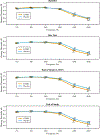Ototoxicity of Long-Term α-Difluoromethylornithine for Skin Cancer Prevention
- PMID: 35620919
- PMCID: PMC9701242
- DOI: 10.1002/lary.30231
Ototoxicity of Long-Term α-Difluoromethylornithine for Skin Cancer Prevention
Abstract
Objective: Evaluate the effects of α-difluoromethylornithine (DFMO) on hearing thresholds as part of a randomized, double-blind, placebo-controlled trial.
Methods: Subjects were randomized and assigned to the control (placebo) or experimental (DFMO) group. DFMO or placebo were administered orally (500 mg/m2 /day) for up to 5 years.
Results: Subjects taking DFMO had, on average, increased hearing thresholds from baseline across the frequency range compared to subjects in the control group. Statistical analysis revealed this was significant in the lower frequency range.
Conclusions: This randomized controlled trial revealed the presence of increased hearing thresholds associated with long-term DFMO use. As a whole, DFMO may help prevent and treat certain types of cancers; however, it can result in some degree of hearing loss even when administered at low doses. This study further highlights the importance of closely monitoring hearing thresholds in subjects taking DFMO. Laryngoscope, 133:676-682, 2023.
Keywords: DFMO; cancer; chemoprevention; hearing loss.
© 2022 The Authors. The Laryngoscope published by Wiley Periodicals LLC on behalf of The American Laryngological, Rhinological and Otological Society, Inc.
Conflict of interest statement
Conflict of Interest: The authors report no conflict of interest.
Figures


References
-
- Samoilenko capital O CAC, Milinevska OA, Karnaushenko OV, Shlyakhovenko VA, Zaletok SP. Effect of polyamine metabolism inhibitors on Lewis lung carcinoma growth and metastasis. Experimental oncology 2015; 37:151–153. - PubMed
-
- Pommergaard HC, Burcharth J, Rosenberg J, Raskov H. Combination chemoprevention with diclofenac, calcipotriol and difluoromethylornithine inhibits development of non-melanoma skin cancer in mice. Anticancer research 2013; 33:3033–3039. - PubMed
-
- Meyskens FL Jr., Gerner EW. Development of difluoromethylornithine (DFMO) as a chemoprevention agent. Clinical cancer research : an official journal of the American Association for Cancer Research 1999; 5:945–951. - PubMed
Publication types
MeSH terms
Substances
Grants and funding
LinkOut - more resources
Full Text Sources
Medical
Research Materials

